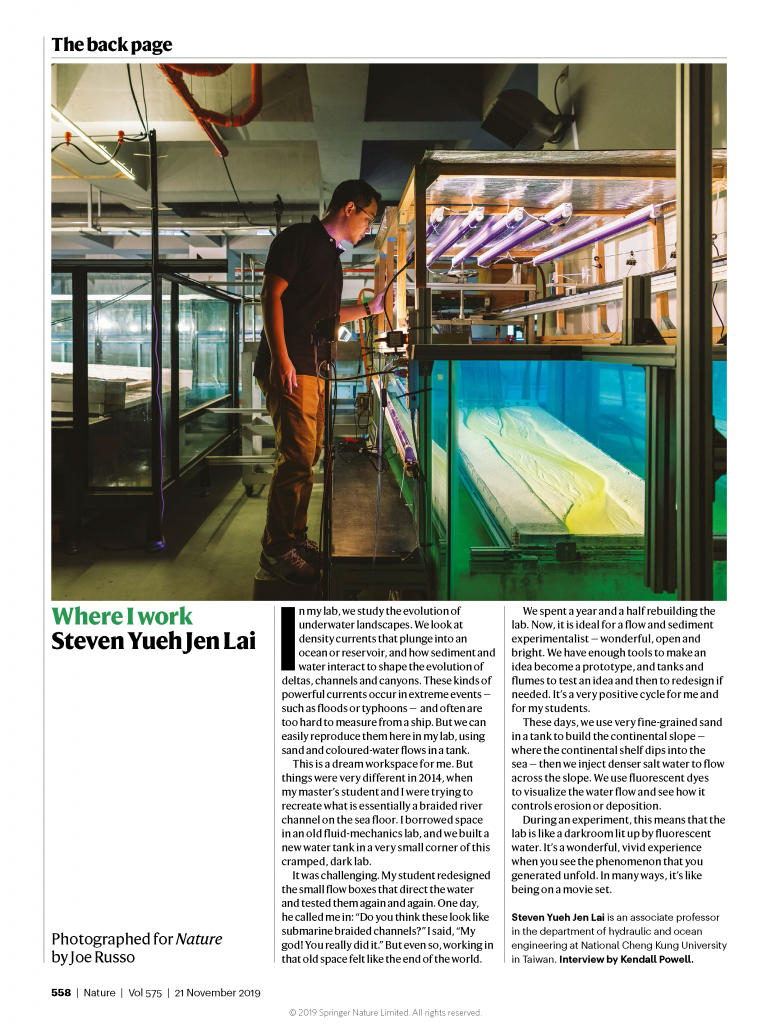
恭賀!!本系賴悅仁教授獲Nature專題報導
Engineering a dream workspace
In my lab, we study the evolution of underwater landscapes. We look at density currents that plunge into an ocean or reservoir, and how sediment and water interact to shape the evolution of deltas, channels and canyons. These kinds of powerful currents occur in extreme events — such as floods or typhoons — and often are too hard to measure from a ship. But we can easily reproduce them here in my lab, using sand and coloured-water flows in a tank.
This is a dream workspace for me. But things were very different in 2014, when my master’s student and I were trying to recreate what is essentially a braided river channel on the sea floor. I borrowed space in an old fluid-mechanics lab, and we built a new water tank in a very small corner of this cramped, dark lab.
It was challenging. My student redesigned the small flow boxes that direct the water and tested them again and again. One day, he called me in: “Do you think these look like submarine braided channels?” I said, “My god! You really did it.” But even so, working in that old space felt like the end of the world.
We spent a year and a half rebuilding the lab. Now, it is ideal for a flow and sediment experimentalist — wonderful, open and bright. We have enough tools to make an idea become a prototype, and tanks and flumes to test an idea and then to redesign if needed. It’s a very positive cycle for me and for my students.
These days, we use very fine-grained sand in a tank to build the continental slope — where the continental shelf dips into the sea — then we inject denser salt water to flow across the slope. We use fluorescent dyes to visualize the water flow and see how it controls erosion or deposition.
During an experiment, this means that the lab is like a darkroom lit up by fluorescent water. It’s a wonderful, vivid experience when you see the phenomenon that you generated unfold. In many ways, it’s like being on a movie set.
Nature 575, 558 (2019)
doi: https://doi.org/10.1038/d41586-019-03537-w
成大新聞中心專訪賴悅仁老師之實驗室及創課空間
撰文/孟慶慈 圖片/賴悅仁
泥沙與水流是如何交互作用塑造出海底峽谷、河道與河口三角洲,大自然長期演變的過程,以往只有推論無法仔細觀察。成功大學水利及海洋工程學系副教授賴悅仁,利用實驗室的水槽以泥沙或樹脂砂與染色水流,呈現現象演變過程,以利科學實證模擬,一舉為新興的「形貌動力學」開啟研究新路徑,結合科學與美學的景觀影像驚艷四方,吸引國際權威期刊Nature特來專訪。
Nature在2019年10月新闢一個專欄「Where I Work」,每期一則故事,圖文並茂介紹全球具特色的科學研究空間,賴悅仁的形貌水力學影像實驗室成為其中之一。賴悅仁自我定位為水流與泥沙的科學家與實驗家。他說,過去想了解水面下的形貌,多半得藉由昂貴的聲納探測,卻也只能了解局部。「別人沒做過的,為什麼不試試看」,透過各種設計,將其他人做不到的現象在實驗室呈現出來。
喜歡美術與設計,極具美學素養,賴悅仁一度曾想轉換跑道去規劃與設計學院。繪畫、素描實力極佳的他,大學就讀成大水利系時期,常思考科學與美學結合的可能性。讀研究所時期,台大指導教授卡艾瑋很重實作,認為「動手做」的學習最深刻,而卡艾瑋老師有高度的美學涵養,師生兩人常探討分享工程科學與美學的看法,這個時期賴悅仁找到了美學與科學結合的可行性,開心地發現「水利系不只是水利工程,還有許多有趣的研究課題」,例如:形貌動力學領域,從此開啟對水利領域的熱忱。
2013年賴悅仁回母系成大水利系任教,授課時只要有機會就融入創客(Maker)精神,帶學生一起「玩水」、「玩沙」,透過實作的過程,希望讓學生感受到水利的意義並產生興趣,日後能繼續留在水利領域耕耘。
不論水面上、水面下或河口,舉凡與水流有關,導致地形、地貌改變的力學行為都稱「形貌動力學」。賴悅仁指出,極端氣候造成的天災日益嚴重,洪水與土石流一再改變地形與水流,嚴重危害生命財產安全。重現景觀演化的實驗,可以了解相關機制與影響範圍,提供的科學資訊或數學模型有助於因應與預測未來,以減緩威脅。
為了讓模擬的水面下景象清楚呈現,賴悅仁挑選白色質地極為細緻的樹脂砂為底沙,使用螢光染料將注入的水流染色,同時也在染色水中添入大量的鹽以增加比重,避免有顏色的水被週遭清水稀釋,如此才能條理清晰的觀看到水流與泥沙是如何沉積或侵蝕,形成海底峽谷、辮狀河道及河口三角洲。
實驗設計費心外,拍攝與紀錄影像更是馬虎不得。拍攝過程如同拍電影般注重色彩與光影,採用不同顏色的燈光,在不同角度架設,連地燈也派上用場,還要調整快門速度,一切的安排就為了取得最佳視覺效果,一目了然看見地形演化。他自豪的說,這可是「科學與美學完美的結合。」
精彩生動的演化影片、照片都會藉由FB(臉書)、Twitter(推特)、YouTube與各界分享,每每獲得廣大迴響。賴悅仁在2019年10月4日上傳一則「視覺化大型辮狀河川演化」實驗影片到Twitter,1週內即近10萬人次點閱, 800多次轉發。
目前國際上只有美國明尼蘇達大學形貌動力學知名學者Chris Paola教授的聖安東尼瀑布實驗室,也做模擬水下辮狀地形演化的實驗。賴悅仁與Paola教授研究交流密切,2015年合作做出全球第一個以科學模擬實證「海底辮狀河道演化」的研究,論文同年登上Nature Geoscience(自然地球科學)期刊。
動手實作已是世界趨勢,回母系任教以來,賴悅仁就希望系上有更多實作空間。2016年水利系全新的海工教學大樓完工,賴悅仁主動請纓,統籌改造水利系館與海工大樓的實驗空間,在2016到2018年時間裡,他費心規劃並闢出大小創客區,新設置數個小型實驗水槽,讓師生有更多的機會就研究主題設計實作,清楚掌握水流、泥沙與波浪之間的互動與影響。賴悅仁從課堂觀察發現,學生對於改造後的實驗空間與環境反應很正面,學習動機與心態都很積極,認為假以時日一定會對水利系的課程規劃與發展產生正面影響,培育出更多水利人才。而他自己也在這個夢想實驗室裡,一次次地做出令人讚嘆不已的水沙互動地形演化實驗。



